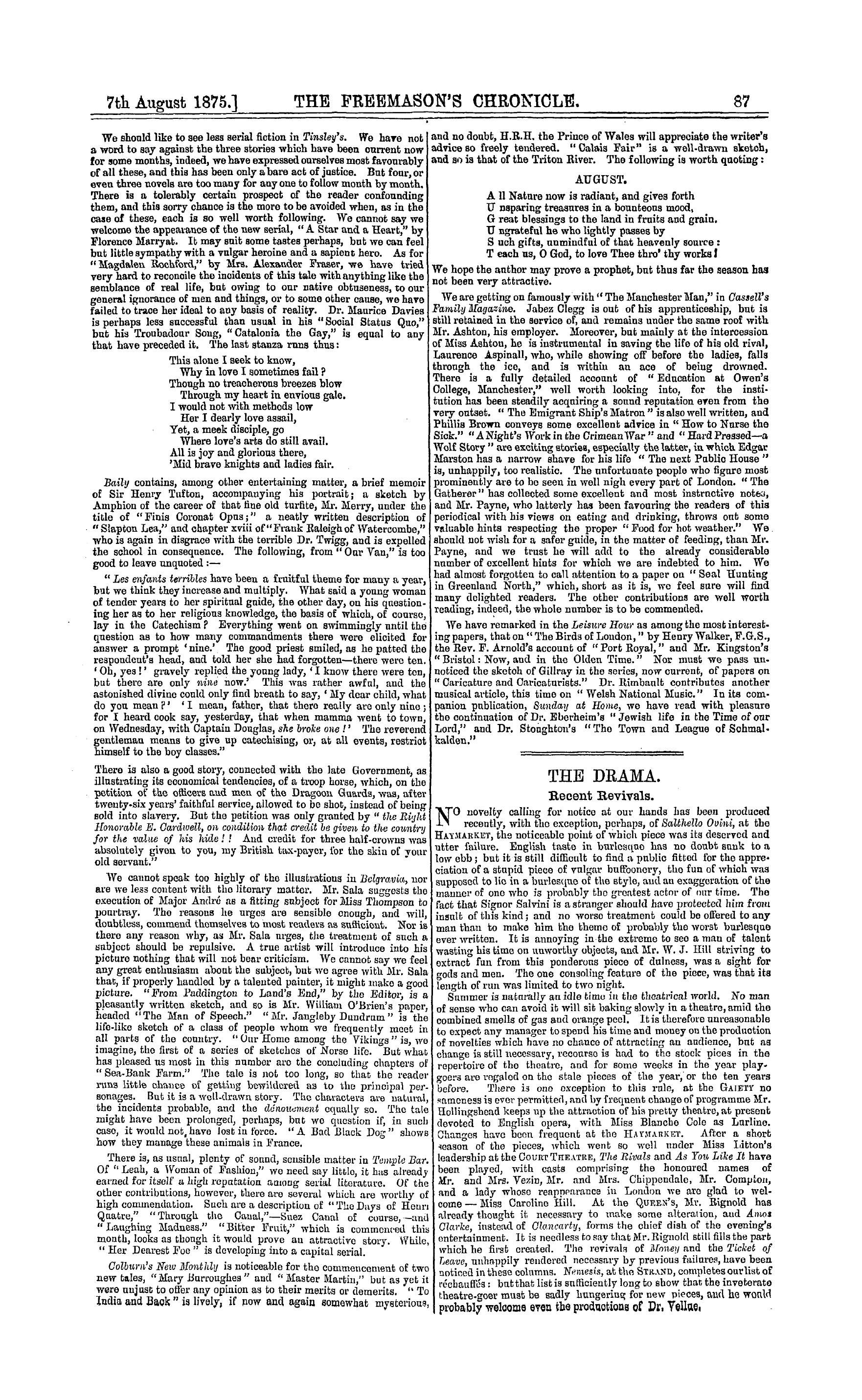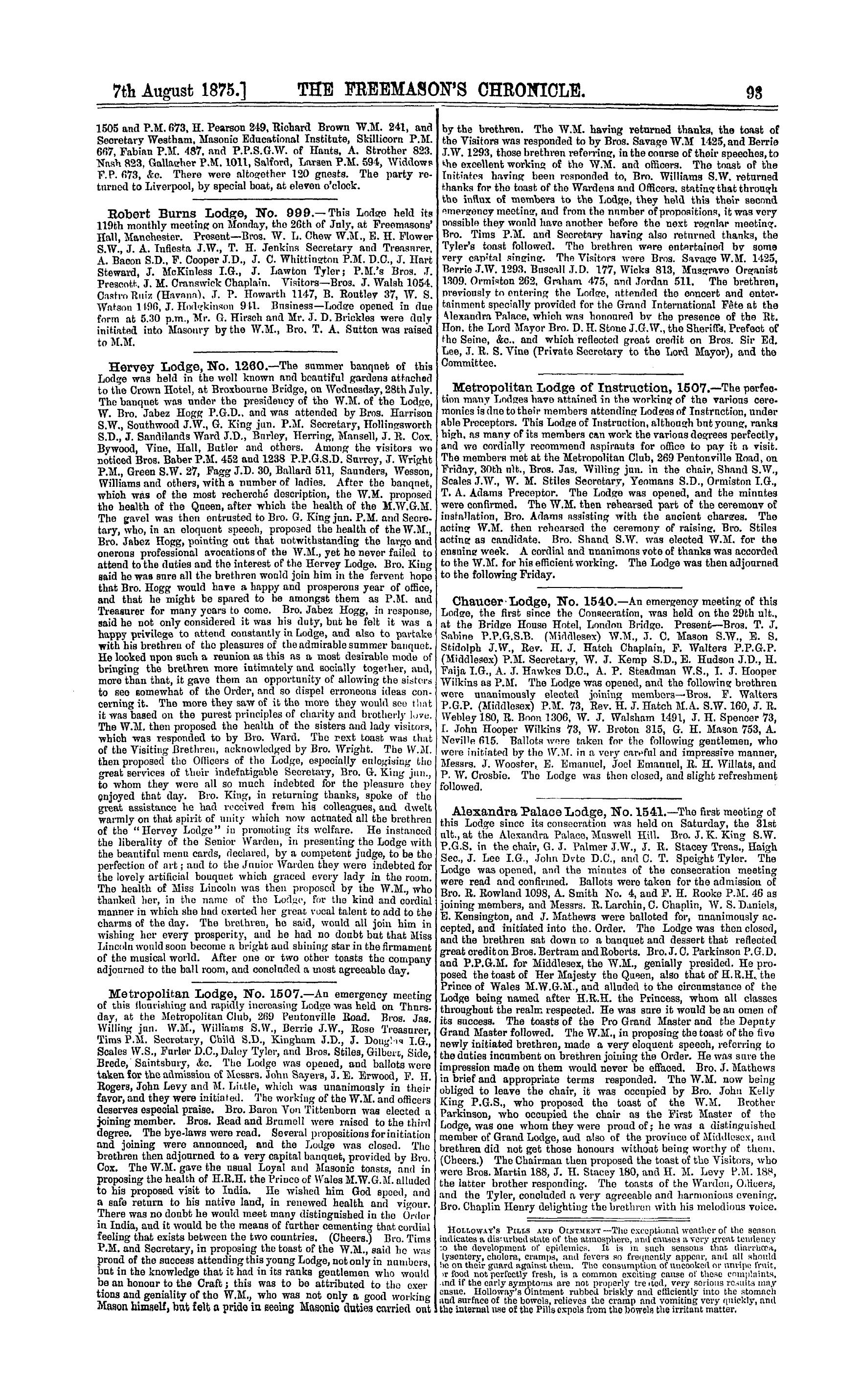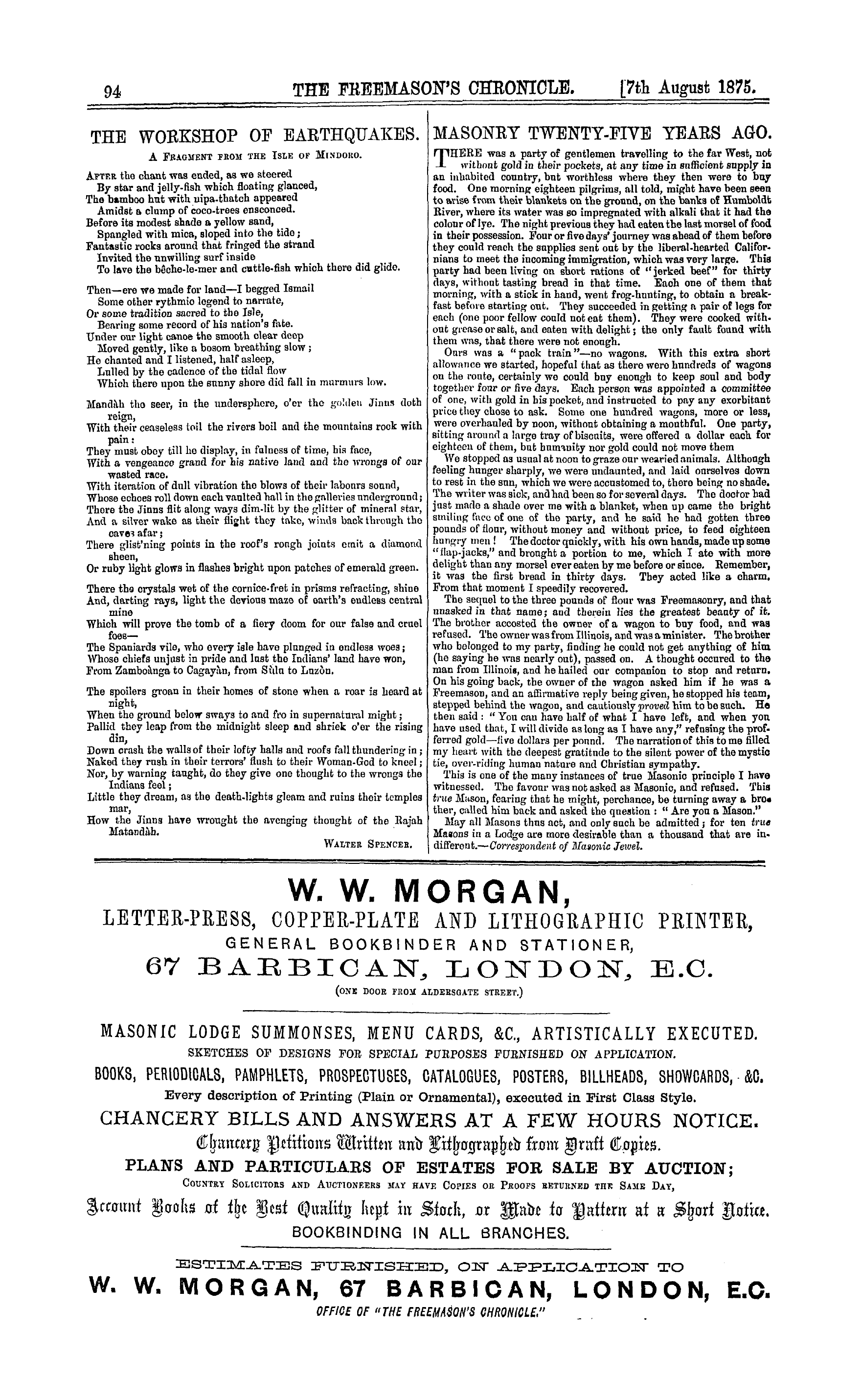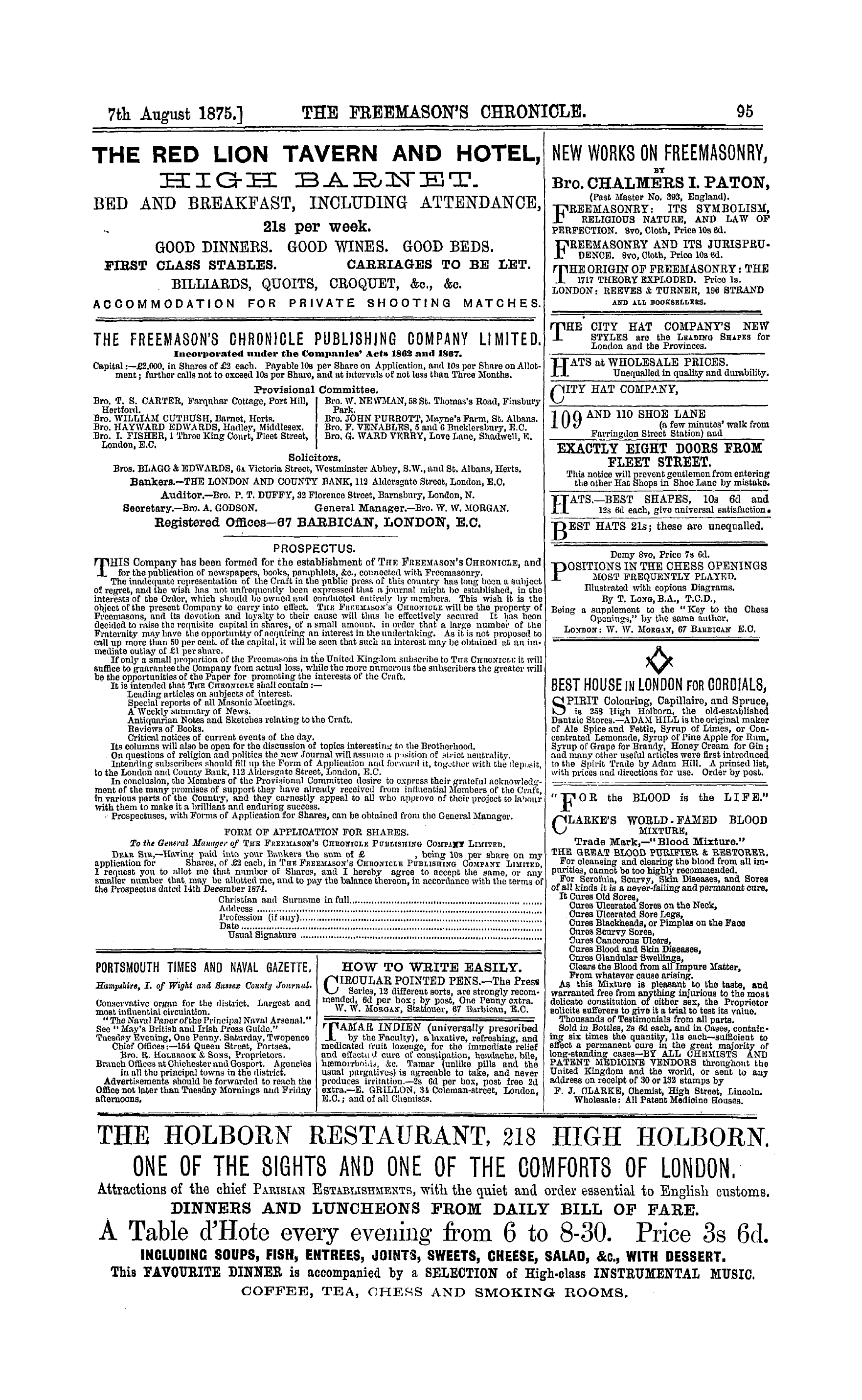-
Articles/Ads
Article THE PRESS AND THE CRAFT. ← Page 2 of 2 Article THE EGYPTIAN PRIESTS. Page 1 of 2 Article THE EGYPTIAN PRIESTS. Page 1 of 2 →
Note: This text has been automatically extracted via Optical Character Recognition (OCR) software.
The Press And The Craft.
indifference implied , though not expressed , reaches some of our friends on this side of the Atlantic . Active Masons here have often complained of that Masonic indifference , which is more difficult to conquer than any of the other failings of mankind . People who blow neither hot nor
cold have , from time immemorial , been regarded with aversion and contempt by earnest workers . The sacred Scriptures tell ns that tbe lukewarm professor of religion is an obnoxious person , compared with whom a zealous sinner , if we may use such a paradox , seems
blameless . The sacred writer , no doubt , meant us to understand that he who possesses a knowledge of a truth or truths , and does not act upon his knowledge , is more deserving of censure than the ignorant transgressor who knows not what he is doing . The Mason who blows neither hot nor cold has indeed little excuse for his
indifference . He knows that he incurred sacred obligations when he joined the Order , that he was expected to work in the cause of philanthrophy , and that be could not , without violating his pledges , live as if he stood alone in the world . But he has chosen an attitude of indifference , and he , and
such as he , alone prevent the ultimate triumph and universal spread of Masonry over the world . The pnblic point to him as a person in no wise improved by his connection with the Order , and an inference is at once drawn from the fact adverse to the claims of the Craft . Of
course the conclusion is an illogical one , but men who reflect or reason are rare , and it not seldom happens that one indifferent Mason may do more indirect harm to the cause than can be repaired by the life work of an enthusiastic brother . We might perhaps
complain , looking at the matter from our own standpoint , of the indifference of English Masons to the claims of their own press organs . The reproach has been levelled at the Craft by more than one disappointed projector , bnt Ave bave always said that as a general charge it is unjust . We
still hold to this view . More , indeed , might be done for the press , but we do not think that it would be fair to charge our brethren generally with indifference to Masonic journalism . In this sphere of labour indeed much remains
to be done , and although the work of making known the claims , and extending the circulation of a newspaper may be less inviting than much of that which attracts many zealous labourers , it is not the less of grave importance to the fraternity at large .
The Egyptian Priests.
THE EGYPTIAN PRIESTS .
( FEOM THE FBENCH OF J . L . LAUBENS . )
( Continued from page 67 . ) IT comes naturally within the scope of the inquiry we have entered upon to say something of the religion of the ancient Egyptians . It would , in fact , be very singular
if we spoke of the priests of ancient E gypt , and examined the nature of that celebrated body , without casting so much as a glance at the reli gion they professed or expounded to the people .
Nothing is so difficult to grasp as the doctrine the ancient Egyptians professed . The historians of these remote ages have transmitted to us , as regards this , rather lyrical pieces than veritable annals . The monuments , with which Egypt is covered even at this day , appear to be the sole records
we can consult with any advantage . Did the Egyptians reverence as gods the sacred animals , and especially the bull Apis , or did they merely look upon them as allegories ?
This question would be problematical , if there did not remain to us of this people the theology , if I may so express myself , of the Pyramids , and the hieroglyphic figures with which they are inscribed .
The manner in which the Pyramids are built deserves special attention , whether we regard them as monuments of science or of religion . As the former , these bear witness to the high degree of excellence this people had attained in geometry and astronomy . As the latter , it is sufficient
to look at the squares which compose those enormous masses and their exact correspondence with the four cardinal points , it is sufficient to cast a glance at the elevation of the summit , which receives exactly at mid-day the reflection of the sun ' s disc once before the vernal and once before the autumnal equinox as well as of the full moon of the equinoxes when in . that parallel 5 in a word , it is sufficient to consider that
The Egyptian Priests.
the worship of Isis and Osiris is but the worship of the sun and moon , as Porphyrus and Diodorus Siculus testify , and as has been proved long since , in order to convince ourselves that the Pyramids of Egypt are nothing more than allegorical figures of the religion of ancient Egypt . These
are the travels of Isis ( the moon ) after the death of Osiris ( the sun ) , which were celebrated by the Egyptians under cover of an allegory , the meaning of which contains tho exposition of the world's first two causes , which have
confirmation in the heavens . Such are the figures which explain the whole system of the religion of the Egyptians . That religion , as we see , was confined to the worship of Isis and Osiris , that is to say of the sun and moon , which embrace all nature . Then we must bear in mind that the
class of worship the people had adopted from the sacred animals , and more particularly from the bull Apis , was a relic of some former religion , traces of which the Egyp tian Priests had found it expedient to preserve out of a respect for old popular customs , the toleration of which
was thought desirable , almost as among us we find , in certain villages in Europe , where Christianity is the dominant religion , sundry relics of pagandom , like the carnival and other customs , the legitimacy of which lies in an immemorial usage , which it has been necessary to preserve and tolerate .
As regards the hieroglyphic figures with which the Pyramids of Egypt are inscribed , there is reason to believe that they are the common explanation and development of the doctrines inculcated by the religion of Isis and Osiris . Those hieroglyphics have long exercised the sagacity of
savants , they have given rise to strange commentaries , and in their anxiety to explain them , people have found nothing but incoherence and obscurity . But hieroglyphic figures , like everything that is emblematic , form a language which it is necessary , above all , to acquire , for it is with
hieroglyphics as with writing ; how can we understand a book if we know not how to read ? Let a book be placed before the eyes of the best mentally developed and most intelligent
man , who , however , has no knowledge of the art of writing . He will understand nothing , and if he sets himself to criticising the sense of what is written without knowing how to read , what errors will he not commit ?
Thus , ancient monuments bear witness that the priests of Egypt possessed the highest knowledge , and that they turned it to good account , with a view to govern nations and enlighten the world . The aspect of those obelisks , those Pyramids , that lake of Mceris , those vast caverns , even
to this day astonish the traveller whom curiosity summons to those countries , once so favoured by nature , but now become the theatre of barbarism and ambition , and menaced by the near invasion of a burning and destructive sand . Those inanimate remains of the greatness of ancient
Egypt still convey to the mind of the learned liberal and sublime ideas . If they have excited astonishment throughout the world when they were yet new , what tribute of
admiration should they not demand from us ? What intense regret must we not feel that we are so ill-informed of a country where such great wonders testify to man what is its power , what the resources of its industry .
It were to push a blind ignorance too far to regard these monuments , every part of which elevates the soul and excites our mental powers , as only the miserable relics of the pride and ostentation of the ancient masters of Egypt . Why ! The Egyptians would never have employed so
much time , they never would have made such tremendous efforts , merely to hand down to posterity the barren and empty evidences of their pomp and ostentation , which is nothing more than a regard of littleness of mind to inspire such grandeur . Can the effeminacy of pomp and
tho inanity of pride excite in the minds of men such noble resolves ? If the Egyptians had aspired to nothing else than the admiration of posterity , would they not have found , in monuments of some other kind , a means for exciting enthusiasm without going and piling up , at heavy
cost , in the midst of a vast champagne , or on thesnuimng of lofty hills , stones of enormous size , perfectly wrought , and methodically and scientifically arranged , without digging vast caverns or opposing dykes to the power of the waves in order to mark out for them eternal limits ? If they
had not had in view to hand down to us ideas of the last importance , would they with so much care and skill have combined astronomy with geometry , and the language of hieroglyphics with architecture ? The cities of Thebes , of Memphis , of Heliopolis , and Sai ' s , contained wonders enough , without rendering it necessary to erect at a
Note: This text has been automatically extracted via Optical Character Recognition (OCR) software.
The Press And The Craft.
indifference implied , though not expressed , reaches some of our friends on this side of the Atlantic . Active Masons here have often complained of that Masonic indifference , which is more difficult to conquer than any of the other failings of mankind . People who blow neither hot nor
cold have , from time immemorial , been regarded with aversion and contempt by earnest workers . The sacred Scriptures tell ns that tbe lukewarm professor of religion is an obnoxious person , compared with whom a zealous sinner , if we may use such a paradox , seems
blameless . The sacred writer , no doubt , meant us to understand that he who possesses a knowledge of a truth or truths , and does not act upon his knowledge , is more deserving of censure than the ignorant transgressor who knows not what he is doing . The Mason who blows neither hot nor cold has indeed little excuse for his
indifference . He knows that he incurred sacred obligations when he joined the Order , that he was expected to work in the cause of philanthrophy , and that be could not , without violating his pledges , live as if he stood alone in the world . But he has chosen an attitude of indifference , and he , and
such as he , alone prevent the ultimate triumph and universal spread of Masonry over the world . The pnblic point to him as a person in no wise improved by his connection with the Order , and an inference is at once drawn from the fact adverse to the claims of the Craft . Of
course the conclusion is an illogical one , but men who reflect or reason are rare , and it not seldom happens that one indifferent Mason may do more indirect harm to the cause than can be repaired by the life work of an enthusiastic brother . We might perhaps
complain , looking at the matter from our own standpoint , of the indifference of English Masons to the claims of their own press organs . The reproach has been levelled at the Craft by more than one disappointed projector , bnt Ave bave always said that as a general charge it is unjust . We
still hold to this view . More , indeed , might be done for the press , but we do not think that it would be fair to charge our brethren generally with indifference to Masonic journalism . In this sphere of labour indeed much remains
to be done , and although the work of making known the claims , and extending the circulation of a newspaper may be less inviting than much of that which attracts many zealous labourers , it is not the less of grave importance to the fraternity at large .
The Egyptian Priests.
THE EGYPTIAN PRIESTS .
( FEOM THE FBENCH OF J . L . LAUBENS . )
( Continued from page 67 . ) IT comes naturally within the scope of the inquiry we have entered upon to say something of the religion of the ancient Egyptians . It would , in fact , be very singular
if we spoke of the priests of ancient E gypt , and examined the nature of that celebrated body , without casting so much as a glance at the reli gion they professed or expounded to the people .
Nothing is so difficult to grasp as the doctrine the ancient Egyptians professed . The historians of these remote ages have transmitted to us , as regards this , rather lyrical pieces than veritable annals . The monuments , with which Egypt is covered even at this day , appear to be the sole records
we can consult with any advantage . Did the Egyptians reverence as gods the sacred animals , and especially the bull Apis , or did they merely look upon them as allegories ?
This question would be problematical , if there did not remain to us of this people the theology , if I may so express myself , of the Pyramids , and the hieroglyphic figures with which they are inscribed .
The manner in which the Pyramids are built deserves special attention , whether we regard them as monuments of science or of religion . As the former , these bear witness to the high degree of excellence this people had attained in geometry and astronomy . As the latter , it is sufficient
to look at the squares which compose those enormous masses and their exact correspondence with the four cardinal points , it is sufficient to cast a glance at the elevation of the summit , which receives exactly at mid-day the reflection of the sun ' s disc once before the vernal and once before the autumnal equinox as well as of the full moon of the equinoxes when in . that parallel 5 in a word , it is sufficient to consider that
The Egyptian Priests.
the worship of Isis and Osiris is but the worship of the sun and moon , as Porphyrus and Diodorus Siculus testify , and as has been proved long since , in order to convince ourselves that the Pyramids of Egypt are nothing more than allegorical figures of the religion of ancient Egypt . These
are the travels of Isis ( the moon ) after the death of Osiris ( the sun ) , which were celebrated by the Egyptians under cover of an allegory , the meaning of which contains tho exposition of the world's first two causes , which have
confirmation in the heavens . Such are the figures which explain the whole system of the religion of the Egyptians . That religion , as we see , was confined to the worship of Isis and Osiris , that is to say of the sun and moon , which embrace all nature . Then we must bear in mind that the
class of worship the people had adopted from the sacred animals , and more particularly from the bull Apis , was a relic of some former religion , traces of which the Egyp tian Priests had found it expedient to preserve out of a respect for old popular customs , the toleration of which
was thought desirable , almost as among us we find , in certain villages in Europe , where Christianity is the dominant religion , sundry relics of pagandom , like the carnival and other customs , the legitimacy of which lies in an immemorial usage , which it has been necessary to preserve and tolerate .
As regards the hieroglyphic figures with which the Pyramids of Egypt are inscribed , there is reason to believe that they are the common explanation and development of the doctrines inculcated by the religion of Isis and Osiris . Those hieroglyphics have long exercised the sagacity of
savants , they have given rise to strange commentaries , and in their anxiety to explain them , people have found nothing but incoherence and obscurity . But hieroglyphic figures , like everything that is emblematic , form a language which it is necessary , above all , to acquire , for it is with
hieroglyphics as with writing ; how can we understand a book if we know not how to read ? Let a book be placed before the eyes of the best mentally developed and most intelligent
man , who , however , has no knowledge of the art of writing . He will understand nothing , and if he sets himself to criticising the sense of what is written without knowing how to read , what errors will he not commit ?
Thus , ancient monuments bear witness that the priests of Egypt possessed the highest knowledge , and that they turned it to good account , with a view to govern nations and enlighten the world . The aspect of those obelisks , those Pyramids , that lake of Mceris , those vast caverns , even
to this day astonish the traveller whom curiosity summons to those countries , once so favoured by nature , but now become the theatre of barbarism and ambition , and menaced by the near invasion of a burning and destructive sand . Those inanimate remains of the greatness of ancient
Egypt still convey to the mind of the learned liberal and sublime ideas . If they have excited astonishment throughout the world when they were yet new , what tribute of
admiration should they not demand from us ? What intense regret must we not feel that we are so ill-informed of a country where such great wonders testify to man what is its power , what the resources of its industry .
It were to push a blind ignorance too far to regard these monuments , every part of which elevates the soul and excites our mental powers , as only the miserable relics of the pride and ostentation of the ancient masters of Egypt . Why ! The Egyptians would never have employed so
much time , they never would have made such tremendous efforts , merely to hand down to posterity the barren and empty evidences of their pomp and ostentation , which is nothing more than a regard of littleness of mind to inspire such grandeur . Can the effeminacy of pomp and
tho inanity of pride excite in the minds of men such noble resolves ? If the Egyptians had aspired to nothing else than the admiration of posterity , would they not have found , in monuments of some other kind , a means for exciting enthusiasm without going and piling up , at heavy
cost , in the midst of a vast champagne , or on thesnuimng of lofty hills , stones of enormous size , perfectly wrought , and methodically and scientifically arranged , without digging vast caverns or opposing dykes to the power of the waves in order to mark out for them eternal limits ? If they
had not had in view to hand down to us ideas of the last importance , would they with so much care and skill have combined astronomy with geometry , and the language of hieroglyphics with architecture ? The cities of Thebes , of Memphis , of Heliopolis , and Sai ' s , contained wonders enough , without rendering it necessary to erect at a















